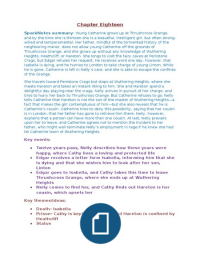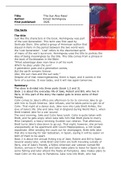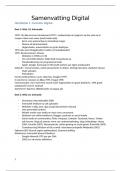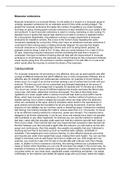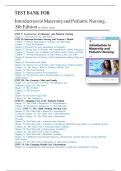Linguistics 3
The Study of Language
Chapter 1 The Origins of Language
Charles Darwin’s vision humans developed musical ability prior to language, used to charm people
Ability to produce sound and simple vocal paterning shared with all vertebrates
Speculaton about the origins of human speech:
- The Divine Source: in most religions, there is a divine source who provides humans with
language.
Experiment 1 Egyptan pharaoh ssammetchus kept two babies in isolaton for two years
(expect for the company of goats). The children were reported to have utered bekos’. The
pharaoh then concluded that shrygian was the original language. Comment: The children
must have heard what the goats were saying and were imitatng that).
Experiment 2 King James the Fourth or Scotland did a similar experiment and the children
were reported to have started speaking Hebrew.
Experiment 3 Mogul emperor Akbar the Great. Children produced no speech.
- The Natural Sound Source: Humans make a connecton between a sound and the thing
producing that sound. This lead to the idea that primitve words derive from imitaton of the
natural sounds. There are two theories about the Natural Sound Source:
Theory 1 The Bow-Wow theory: early humans tried to imitate sounds (onomatopoeia) and
then used them to refer to certain objects even when they weren’t present. This view seems
to assume that a language is only a set of words used as names’ for things.
Theory 2 The sooh-sooh theory: speech developed from the instnctve sounds people
make in emotonal circumstances. But these instnctve sounds are usually produced with
sudden intakes of breath, which is the opposite of ordinary talk.
- The Social Interacton Source: places the development of human language in a social context.
It does not reveal the origins of the sounds produced. Apes live in social groups as well, but
they have not developed the capacity for speech.
Theory yo-he-ho theory: the sounds of a person involved in physical efort could be the
source of our language.
- The shysical Adapton Source: Instead of looking at types of sounds, we can also look at types
of physical features humans possess. At an early stage, our ancestors made a major
transiton to an upright posture. This changed how we breathe. Our rhythm of breathing is
not ted to our rhythm of walking, allowing long artculatons on outgoing breath, with short
in-breaths.
- The Tool-Making Source: some believe that manual gestures may have been a precursor of
language.
- The Genetc Source: there are indicatons that human ofspring are born with a special
capacity for language (innateness hypothesis).
,shysical changes:
- Teeth upright, not slantng outwards, roughly even in height, much smaller. Not very
useful for ripping or tearing food and much beter adapted for grinding and chewing. Also
helpful in making sounds such as f and v.
- Lips more intricate muscle interlacing than is found in other primates and resultng
flexibility helps in making sounds like p, b, and m.
- Mouth relatvely small, can be opened and closed rapidly. sart of an extended vocal tract
that has more of an L-shape than the straight path from front to back.
- Tongue shorter, thicker and more muscular and can be used to shape a wide variety of
sounds inside the oral cavity.
- Larynx the assumpton of an upright posture moved the head more directly above the
spinal column and the larynx dropped to a lower positon.
- sharynx a longer cavity above the vocal folds, which acts as a resonator for increased
range and clarity of the sounds produced via the larynx.
Human brain has specialized functons in each of the two hemispheres (lateralized).The area of
the motor cortex that controls the muscles of the arms and hands is next to the artculatory muscles
of the face, jaw and tongue. There may be an evolutonary connecton and that both were involved in
the development of the speaking brain.
, Chapter 2 Animals and Human Language
Communicatve signals you are intentonally communicatng something by using language
Informatve signals someone listening to you may become informed about you through a number
of signals that you have not intentonally sent (example: you sneezed, so you’re cold).
sropertes of human language:
- Reflexivity humans are able to reflect on the way they create their communicatve
messages or review how they work.
- Displacement humans can refer to past and future tme (excepton: bees have some
version of displacement).
- Arbitrariness there is no natural connecton between a linguistc form and its meaning.
There are some words in language with sounds that seem to echo’ sounds of object or
actvites, but these are very rare. For the majority of animal signals, there is a clear
connecton. This is ted to the fact that, for any animal, the set of signals used in
communicaton is fnite.
- Cultural transmission we acquire a language in a culture with other speakers and not from
parental genes. We acquire our frst language as children in a culture. Human infants growing
up in isolaton produce no instnctve’ language.
- sroductvity the potental number of uterances in any human language is in fnite. Other
creatures do not have this. This lack of productvity in the communicaton system can be
described in terms of fxed reference. Each signal seems to be fxed in terms of relatng to a
partcular occasion or purpose.
- Duality human language is organized at two levels simultaneously. When we speak, we
have a physical level at which we produce individual sounds. As individual sounds, none of
these discrete forms has any intrinsic meaning. In a combinaton with other leters, we have
another level with distnct meanings (example: bin means something else than nib).
The Study of Language
Chapter 1 The Origins of Language
Charles Darwin’s vision humans developed musical ability prior to language, used to charm people
Ability to produce sound and simple vocal paterning shared with all vertebrates
Speculaton about the origins of human speech:
- The Divine Source: in most religions, there is a divine source who provides humans with
language.
Experiment 1 Egyptan pharaoh ssammetchus kept two babies in isolaton for two years
(expect for the company of goats). The children were reported to have utered bekos’. The
pharaoh then concluded that shrygian was the original language. Comment: The children
must have heard what the goats were saying and were imitatng that).
Experiment 2 King James the Fourth or Scotland did a similar experiment and the children
were reported to have started speaking Hebrew.
Experiment 3 Mogul emperor Akbar the Great. Children produced no speech.
- The Natural Sound Source: Humans make a connecton between a sound and the thing
producing that sound. This lead to the idea that primitve words derive from imitaton of the
natural sounds. There are two theories about the Natural Sound Source:
Theory 1 The Bow-Wow theory: early humans tried to imitate sounds (onomatopoeia) and
then used them to refer to certain objects even when they weren’t present. This view seems
to assume that a language is only a set of words used as names’ for things.
Theory 2 The sooh-sooh theory: speech developed from the instnctve sounds people
make in emotonal circumstances. But these instnctve sounds are usually produced with
sudden intakes of breath, which is the opposite of ordinary talk.
- The Social Interacton Source: places the development of human language in a social context.
It does not reveal the origins of the sounds produced. Apes live in social groups as well, but
they have not developed the capacity for speech.
Theory yo-he-ho theory: the sounds of a person involved in physical efort could be the
source of our language.
- The shysical Adapton Source: Instead of looking at types of sounds, we can also look at types
of physical features humans possess. At an early stage, our ancestors made a major
transiton to an upright posture. This changed how we breathe. Our rhythm of breathing is
not ted to our rhythm of walking, allowing long artculatons on outgoing breath, with short
in-breaths.
- The Tool-Making Source: some believe that manual gestures may have been a precursor of
language.
- The Genetc Source: there are indicatons that human ofspring are born with a special
capacity for language (innateness hypothesis).
,shysical changes:
- Teeth upright, not slantng outwards, roughly even in height, much smaller. Not very
useful for ripping or tearing food and much beter adapted for grinding and chewing. Also
helpful in making sounds such as f and v.
- Lips more intricate muscle interlacing than is found in other primates and resultng
flexibility helps in making sounds like p, b, and m.
- Mouth relatvely small, can be opened and closed rapidly. sart of an extended vocal tract
that has more of an L-shape than the straight path from front to back.
- Tongue shorter, thicker and more muscular and can be used to shape a wide variety of
sounds inside the oral cavity.
- Larynx the assumpton of an upright posture moved the head more directly above the
spinal column and the larynx dropped to a lower positon.
- sharynx a longer cavity above the vocal folds, which acts as a resonator for increased
range and clarity of the sounds produced via the larynx.
Human brain has specialized functons in each of the two hemispheres (lateralized).The area of
the motor cortex that controls the muscles of the arms and hands is next to the artculatory muscles
of the face, jaw and tongue. There may be an evolutonary connecton and that both were involved in
the development of the speaking brain.
, Chapter 2 Animals and Human Language
Communicatve signals you are intentonally communicatng something by using language
Informatve signals someone listening to you may become informed about you through a number
of signals that you have not intentonally sent (example: you sneezed, so you’re cold).
sropertes of human language:
- Reflexivity humans are able to reflect on the way they create their communicatve
messages or review how they work.
- Displacement humans can refer to past and future tme (excepton: bees have some
version of displacement).
- Arbitrariness there is no natural connecton between a linguistc form and its meaning.
There are some words in language with sounds that seem to echo’ sounds of object or
actvites, but these are very rare. For the majority of animal signals, there is a clear
connecton. This is ted to the fact that, for any animal, the set of signals used in
communicaton is fnite.
- Cultural transmission we acquire a language in a culture with other speakers and not from
parental genes. We acquire our frst language as children in a culture. Human infants growing
up in isolaton produce no instnctve’ language.
- sroductvity the potental number of uterances in any human language is in fnite. Other
creatures do not have this. This lack of productvity in the communicaton system can be
described in terms of fxed reference. Each signal seems to be fxed in terms of relatng to a
partcular occasion or purpose.
- Duality human language is organized at two levels simultaneously. When we speak, we
have a physical level at which we produce individual sounds. As individual sounds, none of
these discrete forms has any intrinsic meaning. In a combinaton with other leters, we have
another level with distnct meanings (example: bin means something else than nib).


